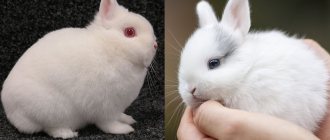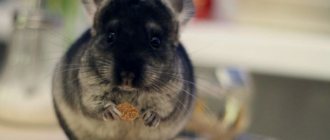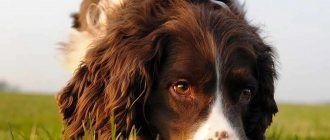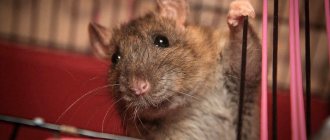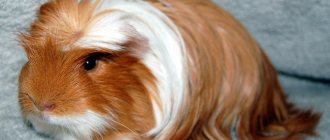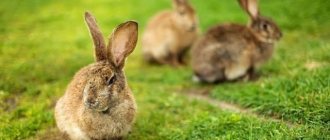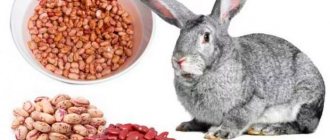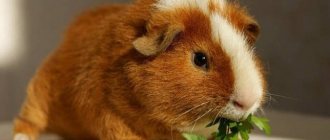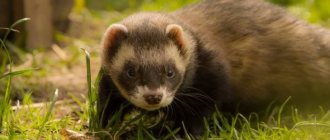Pets are found in almost every home. The decorative rabbit is rapidly gaining popularity. These animals do not need walks outside, take up little space, and are very easy to care for.
However, before you get such a pet, you should find out how long the animal lives, what to feed it and how to properly maintain it. The average life expectancy of dwarf rabbits is 6-12 years.
INTERESTING! The diet of such animals consists of vegetables, grains, fruits, twigs, hay, and licks. They especially love watermelons, sweet apples, carrots, and cucumbers.
PS. Prices are indicated with a wide range and are approximate. Much depends on where to buy a rabbit, under what conditions, availability of documentation, vaccinations and other important points.
Hermelin red-eyed and blue-eyed
There are two varieties of hermelin: with red or blue eyes. The first appeared at the end of the 19th century. Blue-eyed hermelines were obtained at the beginning of the 20th century. Initially, a weight of 750 grams was considered ideal, but in such females fertility was noticeably reduced.
Characteristic:
- Weight: 1100-1350 g.
- Ear length: 3.5-7 cm, straight.
- Wool: medium.
- Color: white.
- Price: 4-10 t.r.
In 1992, Austria released a new standard in which the weight of animals was changed. Hermelines have a strong build. The body is cylindrical, the limbs are short. The coat must be white.
Queen cell
A pregnant rabbit needs a special room, a queen cell, to give birth and hide newborn rabbits from prying eyes. Usually this is a small extension to a cage measuring 40x40x30 cm, into which a round hole leads. The queen cell looks like a hole. But the roof still needs to be made removable in order to control the behavior of the young mother, remove stillborn babies, and see if everyone has enough milk. A few days before giving birth, the female rabbit lines the bottom of the queen cell with her down. No assistance required during childbirth. She will also take care of the newborn rabbits herself. You just need to provide her with enough quality food and fresh drinking water. If the mother feels a lack of one or the other, she may eat her offspring.
Colored dwarf
The breed was founded by the German breeder Hoffmann. By 1957, he had received a fairly large population of different colors: Marder, black, gray, Siamese, blue, etc. This breed is distributed throughout the world and is the most numerous.
Peculiarities:
- Weight: 1000-1500 g.
- Ears: 5.5 cm, straight.
- Coat type: medium.
- Any colour.
- How much does it cost: 3-7 tr.
The body of a colored dwarf has the shape of a cylinder. The front legs are short, the head is quite large, but short. The coat is shiny, medium length, thick. There should be no dewlap. Any color is allowed.
Colored dwarf Dutch
A breed that was obtained in the Netherlands. It was officially recognized in 1940. To obtain it, they used hermelins and local small rabbits. Such animals appeared in Russia in 2013.
Characteristic:
- Weight: 800-1300 g.
- Ear length: 5-7.5 cm, straight.
- Wool: medium.
- Color: any.
- Price: 2-7 t.r.
Small rabbits whose weight should not exceed 1300 grams. The head has a rounded shape. The muzzle is wide, the eyes are round and large. The ears are located close to each other. The limbs are short and adjacent to the body.
Netherland dwarf rabbit
The ancestor of the breed is the red-eyed Hermelin. They have spread throughout the world. These rabbits were brought to Russia from Finland in 2014. There are two lines of the breed: English and American.
Peculiarities:
- Weight: 900-1150 g.
- Ears: 5-7.5 cm, straight.
- Coat type: medium.
- Any colour.
- Cost: 4-8 tr.
The ideal weight of an adult Netherland rabbit is 950 grams. The body is compact, the body has a rounded short format. The length of the ears varies from 5 to 7.5 cm. The breed standard includes 37 colors: solid, agouti, Siamese, tan, etc.
Where is the best place to buy a decorative rabbit?
You can buy a baby rabbit:
- in the nursery;
- in a pet store;
- at the poultry market;
- through an Internet bulletin board.
Breeders advise using the first two options. By purchasing an animal from a specialized institution, you receive a guarantee that the baby is healthy, vaccinated and meets the breed standard.
As you can see, there are many varieties of decorative rabbits. The main advice is to choose your pet with your heart. Then he will become a friend and a full-fledged member of the family.
Polish rabbit or Dwarf hare
This dwarf rabbit is considered the smallest of all decorative breeds. Such animals came to Russia only in 2014. The most common Polish rabbits are in England and Scandinavian countries.
Characteristic:
- Weight: 500-1400 g.
- Ear length: 5-6 cm, straight.
- Wool: medium.
- Color: any.
- Price: 7-15 t.r.
Outwardly, these rabbits resemble a wild hare. The head is light and egg-shaped. The legs are long, thin, adjacent to the body. The coat is thick and about 2 cm long. Polish rabbits should not have dewlaps.
Practical advice
Basic tips:
- It is advisable to play with pets in the evening - during the day the animals sleep or hide;
- Rabbits often make noise at night. Therefore, it is necessary to teach them to adapt to their own routine - to accustom them to sleep at night;
- It is imperative to follow the vaccination schedule. During infectious outbreaks, the list of mandatory vaccinations may be expanded;
- to avoid the appearance of an unpleasant odor, the pet should be sterilized in a timely manner;
- To prevent your pet from starting to cause mischief, you should put pieces of wood in the cage - he will chew them;
- It is recommended to use small balls or boxes with holes as toys. If there are not enough toys, the rabbit will start tearing the wallpaper.
Most breeds do not get along well with cats and dogs. To prevent the rabbit from getting bored, it is best to move him with a fellow tribesman - preferably of the same breed.
Dwarf rex
The first dwarf rexes appeared in France in 1919. They differ from other breeds in having very short hair. It is velvety and “plush” to the touch. Another feature is a short and curly mustache.
Peculiarities:
- Weight: 1000-1500 g.
- Ears: 3.5-7 cm, straight.
- Coat type: short.
- Any colour.
- Cost: 5-10 tr.
The Rex's body is stocky, compact, and slightly elongated. The length of the coat does not exceed 17-18 mm. It grows vertically and should not be curly or wavy. When stroking, the hairs return to their original position. The head is short, rounded, large. The eyes are large and expressive.
How to toilet train an animal
Accustoming a baby rabbit to a litter tray requires a lot of patience from the owner.
The little rabbit is gradually getting used to the toilet, but you will have to be a little patient. It is advisable to remember in which corner the breeder had the tray and place it there at home. It is worth asking the breeder for some used litter and mixing it with the old one. The pet will quickly find its native smell.
If the baby doesn't get into the tray, there's no need to swear. As soon as it becomes noticeable that your pet wants to go to the toilet, you must immediately put him in the litter tray. After a job done successfully, the animal should be praised. If you patiently train your pet to use the toilet day after day, the result will be achieved.
Satin dwarf
An American breed of rabbits with a special guard hair structure. It has a hollow shaft that reflects light well and gives the wool a unique shine. The first mutation occurred in 1934, after which these animals began to be purposefully bred.
Characteristic:
- Weight: 1500-2200 g.
- Ear length: 6-9 cm, straight.
- Wool: medium.
- Color: white, black, chocolate, red, chinchilla, Siamese, otter, opal.
- Price: 2-9 t.r.
A dwarf variety of satin rabbits was obtained not so long ago. Their body is slightly elongated, their back is rounded. The peculiarity of satin rabbits is their shining and iridescent fur, thanks to which it is impossible to confuse these animals with other breeds.
Nutrition
In summer, rabbits are fed mainly with forbs, leaves of bushes and fruit trees, vegetables, fruits, and root crops. And also roughage: grains, legumes, compound feeds. The grass should be given pre-dried to improve digestion. Potatoes, carrots, beets, and celery must first be washed well.
The basis of the eared diet is hay, food, fruits and vegetables, twigs and clean fresh water.
There should always be enough hay in the hay barn. Feeding dry grass helps normalize digestion.
Special food is very important for animals, as it saturates the animals and contains the necessary nutrients. It comes in the form of grain food for rodents, or as a combined food. Compound feed is often chosen for feeding eared animals, as it promotes the growth of small individuals. Feed is given one tablespoon three times a day. Adults are given twice a day. The animals eat the tasty grains first without touching other parts of the feed. But you should not remove them immediately; it is recommended to wait until the pet has eaten the entire portion.
Teeth wear down on tree branches and solid food particles. Rabbits can be treated to branches of pear, poplar, willow, apple, and birch. The branches must first be washed and dried.
Salt and vitamin stones are sold in stores. They are useful to give to rodents. They ensure the supply of vitamins and minerals to the animals’ bodies.
There should always be boiled water in the drinking bowl. It needs to be changed every day.
Rabbits are given fresh plants: dandelion, alfalfa, yarrow and others. First, the pet is given a leaf to try and the body’s reaction to the new food is observed. If your pet liked the food and accepted it well, then you can give more of this herb next time. If your pet has problems with stool, then there is no need to give this plant.
Chalk and salt are needed all year round. 1–2 g of chalk and 0.5–1 g of salt per individual per day.
It is important for a rabbit breeder to know how to care for rabbits that have recently been taken from their mother. They still have a weak, not fully formed digestive system. Therefore, they cannot be fed with roughage and dry food, grains, legumes, and hay. It is better to give young animals tender young grass, vegetables, and boiled potatoes.
Rabbits' food should not contain cabbage and beets. But the animals like apples, pears and carrots.
Fox dwarf rabbit
These animals were bred in Germany. To obtain them, ordinary medium-sized fox rabbits were crossed with miniature Hermelines, and dwarf Angora rabbits were also used to lengthen their fur.
Peculiarities:
- Weight: 1110-1250 g.
- Ears: 4-6.5 cm, straight.
- Coat length: medium-long.
- Any colour.
- Cost: 3-7 tr.
The fur of fox rabbits is thick and quite long (from 3.5 to 5 cm). It feels very soft and silky to the touch. The body is cylindrical, strong, and well-knit. The legs are short, the head is round and large.
Cage equipment
You can buy ready-made cages or build your own. To do this you will need metal mesh, plywood, boards and slats. The approximate size of the housing for two individuals is 60x70x50 cm. The floor in the cage is made of mesh or made of slats with an interval of 1–1.5 cm. The front wall is also made of mesh, the back and sides are solid. Cells can be arranged in several tiers. If the building is located on the street, it is necessary to make a roof or canopy and provide insulation for cold weather. Straw, sawdust or spruce branches are laid on the floor.
The rabbitry is located on the site so that the front part of the cages faces southeast. In winter, the cages are moved to a heated barn. If they remain outside, they are insulated with polystyrene foam, mineral wool, grass mats and other heat-insulating materials.
Lion-headed dwarf rabbit
These animals were the result of a genetic mutation and appeared from crossing the Belgian dwarf and Swiss fox breeds. Subsequently, breeders used Angora dwarfs to improve the quality of the wool of lion-headed rabbits.
Characteristic:
- Weight: 850-1500 g.
- Ear length: 4.5-6 cm, straight.
- Coat: medium, long on the head.
- Color: any.
- Price: 5-9 t.r.
The peculiarity of such rabbits is very long hair around the ears and on the cheeks, forming a characteristic “mane”. At the same time, the hairs on the body do not exceed 3-5 cm in length. These animals are very common; they can be found more often than others in apartments and houses.
Conditions of detention
Keeping a decorative rabbit at home requires some skill. Long-eared animals cannot stand the heat, but they can be helped. The ears of animals have the function of thermoregulation. To cool the body temperature, wipe the animal's ears with a damp cloth from the outside. To reduce the temperature inside the cage, place a towel soaked in cold water over it, and place a bottle of cold water and ice in the cage.
Rabbits are quite shy animals. Harsh sounds cause them stress, which subsequently has a negative impact on their health. And if a loudly barking dog lives in an apartment, then such a sound can cause the long-eared pet’s heart to stop.
To establish a trusting relationship between the owner and the pet, the animal needs to be stroked and periodically held in your arms. They do this not every time the owner wants, but when the rabbit is awake. You cannot shout at your pet, as their hearing is sensitive, the owner’s cry is perceived as a bolt from the blue.
The rodent needs to go for a walk every day to develop and maintain its physical skills. But while walking, you need to keep an eye on your pet.
Dwarf Angora
The first dwarf angoras appeared in Russia in 1997. They were brought from Poland. Breeders began active work to improve the breed and received a large group of animals with the same pubescence and body weight.
Peculiarities:
- Weight: 900-2000 g.
- Ears: 5-7.5 cm, straight.
- Coat length: very long.
- Color: white (with blue or red eyes), Siamese, yellow, black, blue, Havana, etc.
- Cost: 5-15 tr.
Outwardly, the Angora rabbit resembles a fluffy cloud. The fur of these animals is long and grows vertically. The head is very well pubescent, so the animals have almost no nose or eyes visible. These animals require regular grooming.
Diseases
Common diseases
- VGBK;
- gastrointestinal stasis;
- urinary dermatitis;
- coccidiosis;
- myxomatosis;
- pasteurellosis.
If, during a period of heavy molting, a rabbit licks its own fur and the fur of a relative, then lumps of hair accumulate in the stomach. The result is bloating and constipation. There is a risk of intestinal blockage.
Rhinitis in rabbits: causes, symptoms, treatment methods
The main reasons are allergies, colds and infectious pathologies. Symptoms:
- swelling and redness of the nasal membrane;
- wheezing when breathing;
- the formation of crusts from dried secretions.
The animal constantly sneezes and scratches its nose.
Treatment uses drops that are instilled into the nasal passages. Medicines are prescribed by a veterinarian. Additionally, it is necessary to disinfect the rabbit corner.
Pasteurellosis in rabbits
The main symptom is an increase in general temperature to 40 degrees. The animal coughs, sneezes, and breathing becomes difficult.
Treatment uses injections. The medications are prescribed by a veterinarian.
Dwarf ram
Dutch breed of domestic dwarf rabbits. To obtain it, ordinary French large rams were used. These animals are distinguished by their flexible disposition. They are quite phlegmatic, rarely show aggression, and are easy to keep.
Characteristic:
- Weight: 1400-2000 g.
- Ear length: 24-28 cm, drooping.
- Wool: medium.
- Color: any.
- Price: 10-15 t.r.
Small rabbits with long floppy ears. The head is round with large eyes and a wide, slightly flattened forehead. Rams have a wide back, a rounded back, and a strong and well-built physique.
REFERENCE! These animals are prone to gaining excess weight, so food should be given to them in portions and in limited quantities.
First meeting
All you need to know about decorative rabbits is that they are quite shy. Therefore, when meeting for the first time, there is no need to immediately try to cuddle or stroke the animals. Like any other pet, babies need to get comfortable, get used to it, and adapt. If you suddenly rush at him with expressions of love, the rabbit will simply get scared and hide in a corner.
It would be better to carefully and slowly reach out to him and treat him with some goodies. It can be vegetables, fruits.
You need to talk to the rabbit in a gentle, quiet and calm voice - this way he will quickly understand that the new owner does not pose a danger to him.
Dwarf rex ram
To obtain these animals, such breeds of decorative rabbits as dwarf lop-eared rams and rexes were used. Breeding work began at the beginning of the 21st century. These animals appeared in Russia only in 2007. They were officially recognized in 2015.
Peculiarities:
- Weight: 1700-1900 g.
- Ears: 24-28 cm, hanging.
- Coat length: short, plush.
- Any colour.
- Cost: 7.5-20 t.r.
Quite rare and very beautiful animals. The body is of medium length, the head is rounded, slightly elongated. Fold-eared rex rams have round, expressive eyes and long ears. On the head there is a “crown” characteristic of the breed. The coat is short, velvety and plush to the touch.
Features of behavior
Domestic rabbits communicate with their owners using body language. By carefully observing your pet, you can guess what he wants to say:
- If the animal is completely relaxed, it should not be disturbed. Especially when he's lying on his side and looks like he's dead. In this position he feels most comfortable. Perhaps he felt so comfortable and good that he fell asleep.
- Licking the owner's hands is a sign of special affection. With this behavior, decorative rabbits demonstrate a friendly attitude. After all, when rodents living together clean and wash each other, they show that they recognize that their relative belongs to their pack.
- The decorative rabbit rose on its hind legs and stretched its neck. This means that he is interested in some subject. The pet wants to take a closer look at it or tries to reach for the treat.
- The animal constantly rummages in the litter, as if looking for or hiding something. Most likely, the rodent is building a hole. Females usually do this during nesting.
- The animal puts its muzzle to the palm and pushes. This is how he shows that he wants to receive another portion of affection and attention.
- The pet presses its ears and shrinks into a ball. This indicates severe fear or wariness. Perhaps he saw a stranger or heard a sharp sound. The feeling of danger is always accompanied by instinctive muscle contraction. The animal also flattens its ears when it is angry and ready to fight. At such moments, he raises his muzzle. It is better not to approach your pet, but wait until he calms down, and then treat him to a carrot or other treat.
- A domestic rabbit bit my hand. Obviously he didn't like the rough treatment. A pet may bite when it is forcibly pulled out of its cage or pressed too hard. This is why children should be taught how to properly handle an animal.
- The animal grinds its teeth or makes a quiet muttering sound. This is how the pet shows that he enjoys stroking.
The habits characteristic of most rodents are described above. However, each animal has its own character, so the behavior of decorative rabbits under different circumstances may differ.
Lion-headed dwarf ram
To obtain such animals with an unusual appearance, dwarf rams and lion-headed rabbits were used. The breed was officially recognized in 2007 in the UK. In Russia this happened in 2010.
Characteristic:
- Weight: 1600-2200 g.
- Ear length: 24-27 cm, drooping.
- Coat: medium, long on the head.
- Color: any.
- Price: 4.5-12 t.r.
The lion-headed ram has a dense, cylindrical body. The ears are long, hanging, rounded at the ends. The coat on the body is of medium length, but around the ears and on the cheeks it is noticeably longer (up to 15-18 cm).
Puberty
To what age a decorative rabbit grows depends on its breed. Most representatives of dwarf breeds become sexually mature at 4-5 months. The main reason why decorative rabbits bite is the onset of puberty.
The animal can not only bite painfully, but also becomes overly active, even aggressive, begins to ignore the toilet and mark its territory. In such cases, you need to breed animals or castrate decorative rabbits if you do not plan to breed them.
Dutch lop-eared dwarf rabbit
The first representatives of the breed were obtained about 30 years ago. To breed them, breeders crossed Dutch rabbits and French fold rams. For several years, experts have been working to reduce the size of the breed.
Peculiarities:
- Weight: 1250-1700 g.
- Ears: 21-26 cm, hanging.
- Coat length: medium.
- Color: brown, gray, black, blue, marten, isabella, black otter, chinchilla.
- Cost: 3.5-8 tr.
The body of these animals is strong, the back is rounded. Skin without folds, dewlap is not allowed. The head is quite large and round in shape. The neck is short. The eyes of Netherland rabbits are large and expressive.
Determining gender
Determining the sex of rabbits is an important and necessary task for those involved in breeding eared rabbits.
Immediately after birth and until weaning from mother's milk, it is very difficult and impractical to determine the sex.
As soon as the rabbits become more independent, it’s time to determine which of them is which. To do this, you need to place the individual on a hard surface. Holding the pet by the scruff of the neck, lift it and sit it on its tail. With the second hand, they open the fur in the genital area. In females, the genital slit should open, located close to the anus. Males have a round opening that is further from the anus than the female.
In males who have reached puberty, pronounced testicles can be felt.
Mini lop
The breed was bred in Germany. These animals were obtained by crossing Dutch fold rams and dwarf chinchillas. The first mini-lops were white, but later other colors were obtained. The breed was officially recognized in 1980.
Characteristic:
- Weight: 1400-2700 g.
- Ear length: should be 2-3 cm below the jaw, drooping.
- Wool: medium.
- Color: any.
- Price: 8-17 t.r.
Mini lop has a strong body. The head is rounded and quite large. The neck is very short. The limbs are thick, not curved, and short. These rabbits are very good-natured, so even small children can communicate with them without any problems.
Vaccinations
A dwarf pet of any breed must be vaccinated against myxomatosis and hemorrhagic viral disease. Such vaccines can be administered in combination or as a single component. Rabbits are delicate animals that do not tolerate various infections well, so overdue vaccinations can contribute to the death of the ornamental animal. For vaccination, it is better to contact a qualified veterinarian who will determine the age of the pet, the need for medication and the next steps regarding the health of the rodent.
Mini lop lionhead
These animals were obtained in England in the early 2000s, but they are not yet officially recognized. The best representatives of the lion-headed dwarf and mini lop breeds were used for breeding.
Peculiarities:
- Weight: 1500-1600 g.
- Ears: 21-25 cm, hanging.
- Coat length: medium, long in the head area (up to 7.5 cm).
- Any colour.
- Cost: 6-13 tr.
These animals are quite miniature. A characteristic feature of the breed is a very thick mane on the head, while the hair on the body is short (no more than 2 cm). The body is dense, strong, the back is rounded. Lion-headed mini-lops have a round head proportional to the body.
Feeding
Adult rabbits should eat more hay. The diet should also include food and a variety of greens. The water in the drinking bowl should not be oversaturated with calcium.
Rabbit diet:
| Daily | Hay (constantly), food and vegetables (limited), water. |
| Periodically | Fruits, carrots |
| Rarely | Hercules (without sugar) – recommended for sick, weak animals. |
You cannot feed animals milk, meat, fatty foods, sweets, bread, nuts, grains, seeds, or chocolate.
Mini lop cashmere (long-haired)
The first long-haired rabbits were obtained by chance in a litter of standard dwarf rams. This happened in 1980 in England. It was these animals that became the founders of the Cashmere Mini Lop breed.
Characteristic:
- Weight: 1300-1600 g.
- Ear length: 20-24 cm, drooping.
- Coat: long (from 3.8 to 5-6 cm), shorter on the head.
- Color: any.
- Price: 7.5-13 t.r.
Cashmere mini lop has a dense, strong, but small body. The croup is rounded. The neck is very short, almost invisible. Both the forelimbs and hind limbs are thick and short. The peculiarity of the breed is its long, soft, but not plump, hair that is always straight.
Caring for a cat after castration in the first hours
After castration, a cat needs special care. Most veterinary clinics provide post-operative hospital services. In a special box with optimal climatic conditions, the operated pet is observed until it completely recovers from anesthesia. Once convinced that the cat’s condition is satisfactory, it is handed over to its owners.
Care in the first hours after castration comes down to monitoring your pets
If such a service is not available in the clinic or castration is performed at home, it is important to follow the following care recommendations:
To transport a cat after castration, it is recommended to use a loose carrier with a folding top and an absorbent diaper on the bottom. It is forbidden to transport an operated pet in your arms or in a car seat, as when waking up from anesthesia, it can harm itself or its owner. During transportation and further postoperative stay, the cat is placed on its side; It is recommended to lay an anesthetized, operated cat on the floor, since when it comes to its senses, it may fall off the table/sofa/bed. A common symptom of anesthesia sleep is uncontrollable urination. Using an absorbent diaper placed on the floor under the pet will make it much easier to eliminate such a nuisance; During anesthetized sleep, body temperature drops by 1-1.5°, so to prevent hypothermia, the operated pet is placed next to a heating radiator. It is strictly forbidden to place animals near electrical appliances with an open heating element. Instead of a battery, you can use a heating pad or a plastic bottle with hot, but not boiling water, which is placed next to the cat under a bedding or blanket
It is important that the heat does not come into contact with the cat's perineum, as this will cause bleeding. During the warm season, no additional warming procedure is required; for a more comfortable awakening from anesthesia sleep, it is recommended to close the curtains on the windows, since bright sunlight causes irritation of the optic nerve; Anesthesia sleep lasts from 15 to 120 minutes. depending on the method of administration and dose of the drug
During this time, it is necessary to monitor the cat so that it does not bury its nose in anything and suffocate. In addition, cats in this condition do not blink, which can cause the cornea to dry out. It is recommended to drip sterile saline solution, contact lens liquid, or eye drops without antibiotics into the eyes several times;
A protective collar will prevent your pet from licking the wound, further irritating it.
- Often waking up after anesthesia causes aggression in the pet. Therefore, it is recommended to provide the cat with complete rest for 24 hours, limiting access to him by other animals or children. It is forbidden to forcefully wake up your pet. Depending on the individual characteristics, after waking up, the cat may experience an unsteady gait, vomiting, involuntary urination, and a lethargic and drowsy state. This condition can last up to 8 hours, which is normal and should not cause concern;
- the wound on the scrotum after castration is not sutured, so it is recommended to minimize the amount of filler in the tray or replace it with absorbent paper. This will prevent the ingress of small filler particles and subsequent complications;
- A few hours after surgery, there may be slight bleeding from the incision, which is normal and safe for the cat. You can lightly dry the wound with a gauze cloth. In case of significant bleeding of more than 1 ml, you should urgently contact the doctor who performed the operation;
- Medicines prescribed by a veterinarian will help relieve pain. You can tell that a cat needs pain medication by dilated pupils, meowing, pursed paws, and aggression when attempting contact;
- You can prevent the possibility of damage to the healing incision by the cat’s rough tongue during hygiene by wearing a protective collar around the neck for several days. Such a product will limit the cat’s access to the wound without affecting food intake in any way.
Note! Veterinarians recommend castration in the fall or winter months, as during this period the likelihood of infection of the incision during rehabilitation is lower. In the summer, as a preventive measure for infection, the doctor prescribes a 5-day course of antibiotic treatment.
Holland lop
This breed is the result of crossing Dutch dwarf rams and French lops (the weight of these rabbits reaches 4.5 kg). It was officially recognized in America in 1979.
Peculiarities:
- Weight: 1400-1800 g.
- Ears: 12 cm, drooping.
- Coat type: medium.
- Color: fawn, silver, chocolate, white, brown, red.
- Cost: 8-14 tr.
A distinctive feature of Holland Lop rabbits is their almond-shaped ears. Their average length is 12 cm. The body of rabbits is muscular, strong, and the back is rounded. The legs are short and thick, very strong.
Breeds of dwarf rabbits are numerous and varied. At home, they are kept both in cages and freely. They do not require complex care, and most of them have a good-natured and easy-going character.
Disease Prevention
Like people, rabbits suffer from infectious and non-infectious diseases. Most often they suffer from respiratory diseases of the respiratory tract and stomach upset. The symptoms are the same: runny nose, sneezing, redness of the mucous membranes, general weakness during a cold, and loose stools, sometimes with blood, due to gastrointestinal problems. The disease can be triggered by improper keeping of pets: dampness, drafts, crowded cages, poor nutrition and improper care.
To prevent the most dangerous viral diseases, it is necessary to get vaccinated on time. In addition, new animals cannot be immediately added to the main herd. They must be quarantined for three months.
Every business requires knowledge, patience and desire. Enjoy rabbit farming, and we will share the necessary knowledge with you.

